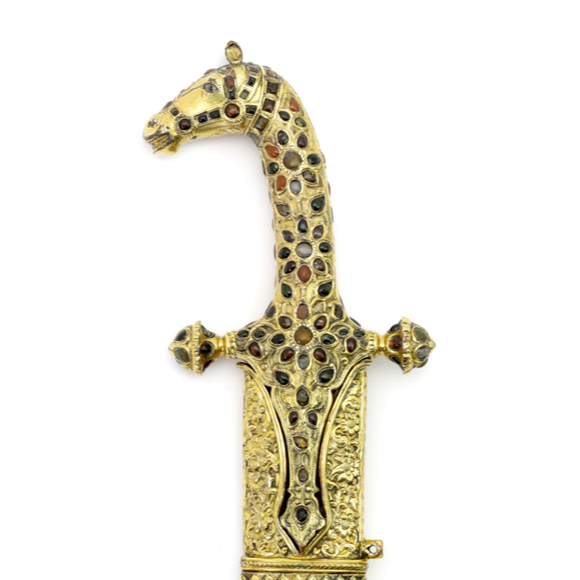With a fine wootz blade with a pronounced center ridge.

38.9 cm
15.8 cm
676 grams
South India
Steel, brass
Probably 19th century
Description
A south Indian pierced iron elephant goad or ankus. Such hooks are used by the mahout (the keepers, trainers and drivers of elephants) to control elephants. The elephant was a huge beast, only those of considerable wealth could afford elephants and thus the ankus also served as a status symbol.
Their importance is underscored by the fact that the best example of South Indian metalwork known in the world is not a sword, but an ankus. Now in the Bostom Museum of Fine Arts, accession number 1995.11.
This example
Made with a thick double-edged point, with openwork center panel. To one side protrudes a recurved hook, also with reinforced thickened tip. Edges and blade surface of the hook are all engraved with palmate motifs. The center panel is elaborately pierced and chiseled. Its decoration consists of fantastic designs of various animals, mythical and existing, some morphed together. Two parakeets in the top and two elephant heads can be made out. Another pair of animals is dog-like, while the last pair resemble two makara.
The tapering steel handle is divided into sections by means of five ribs. The pommel consists of a brass butt piece in the shape of a stylized tiger's head from whose mouth emerges another dog-like creature.
Comparable examples
This piece is part of an illustrious group of very similar pieces:
Metropolitan Museum
One was owned by the famous William Ockelford Oldman of London who sold it to George C. Stone, who published it in his "Glossary" and bequeathed it to the Metropolitan Museum in New York, where it remains under accession number 36.25.1868. The piece has been on loan to the Victoria & Albert Museum for the exhibit: "Maharaja: the splendour of India's royal courts" which ran from October 2009 - January 2010.
This piece is cataloged as 17th century.
The Walters Art Museum
Another example was in the Lockwood De Forest Collection. Acquired by Henry Walters in 1922, who bequeathed it to the Walters Art Museum, 1931. It remains there under accession number 23102.
This piece is also cataloged as 17th century.
Asian Civilizations Museum, Singapore
Yet another example is in the Asian Civilizations Museum in Singapore. Purchased in 1998, probably from Christies. It is kept under accession number 1998-01399.
This piece is cataloged as 17th - 18th century.
National Galleries of Australia
Our final museum reference piece is another remarkably similar piece that was donated to the National Galleries of Australia by Elaine and Jim Wolfensohn. Wolfensohn is economist, investment banker and former ninth president of the World Bank Group. See it here.
This piece is cataloged as being from the 19th to early 20th century.

Two ankus compared.
Left: Metropolitan Museum, New York, accession number 36.25.1868.
Right: This example.
Attribution & dating
As for dating, most museums date their to the 17th century but I cannot find any reason why it would be that old. It seems more likely to me that they were 19th-century pieces, made to be carried during official assemblies and/or parades. They are all notably shorter than most practical ankus which leads one towards a more ceremonial rather than practical function.
Wearing this ankus possibly conveyed a certain status. Elephants were expensive, and dangerous assets in the field. Those who managed to train and control them well were of considerable importance. Elephant trainers were often trusted with important tasks during processions, hunting, and warfare. These under-sized ankuses may have been emblems of rank carried by such persons when not on the elephant, for example when assembling in a durbar, a public official reception.
Condition
Excellent condition. No damage. Only some age-related staining and pitting.
Conclusion
A nice example of an elephant goad or ankus, part of a group of remarkably similar pieces that are now spread over a number of notable museums.















The style typical of Kutch, the execution far above what is normally seen on work from that area.
Nice and complete with opaque green hilt and scabbard mounts.
An early fighting piece with strong reinforcing langet and broad, cobra shaped tip.






